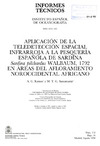Please use this identifier to cite or link to this item:
https://accedacris.ulpgc.es/jspui/handle/10553/52463
| Title: | Aplicación de la teledetección espacial infrarroja a la pesquería española de sardina Sardina pilchardus Walbaum, 1792 en áreas del afloramiento noroccidental africano | Other Titles: | An application of satellite-derived sea surface-temperature data to the fishery of sardine Sardina pilchardus Walbaum, 1792 in areas of the Northwest African Upwelling | Authors: | Ramos, A. G. Santamaría, M. T.G. |
UNESCO Clasification: | 250616 Teledetección (Geología) 510208 Pesca |
Issue Date: | 1998 | Journal: | Informes Tecnicos - Instituto Espanol de Oceanografia | Abstract: | En este trabajo se presentan resultados de la investigación, realizada a partir de imágenes de la temperatura superficial del océano obtenidas mediante el sensor AVHRR (Advanced Very High Resolution Radiometer) a bordo del satélite NOAA-11, de la relación existente entre los rendimientos pesqueros de la flota sardinal de cerco española, entre julio y noviembre de 1992, y los eventos ocanográficos recogidos en el área comprendida entre 24° N y 28° N. Se observó que tres estructuras oceánicas, identificadas mediante teledetección infrarroja (afloramientos, embolsamientos extensos de agua fría y frentes térmicos), acaparaban la mayor parte de las faenas de pesca de la sardina Sardina pilchardus en el área. El rango de la temperatura superficial del océano, SST (Sea Surface Temperature), en las posiciones geográficas con rendimientos pesqueros oscilo entre 17, 61° C y 21, 13° C, mientras sus valores más altos estaban entre 19, 93° C y 21, 13° C. Based on satellite-derived scenarios of sea surface temperature (SST), as measured by the Advanced Very High Resolution Radiometer (AVHRR) on the NOAA-11 satellite, we examined the relationship between the productivity of the Spanish purse-seiner fleet exploiting the fishery of sardine Sardina pilchardus Walbaum 1792, and oceanographic events in the area between 24° N and 28° N, known as the Northwest African Upwelling area, from July to November 1992. Three oceanic structures were observed through infrared remote sensing (upwelling, large cold pockets and thermal fronts), which covered most of the sardine fishing operations in the area. The range of SST in the fishing-grounds was between 17.61 °C and 21.13 °C, and maximum values ranged from 19.93 °C to 21.13 °C. |
URI: | https://accedacris.ulpgc.es/handle/10553/52463 | ISSN: | 0212-1565 | Source: | Informes Tecnicos del Instituto Espanol de Oceanografia [ISSN 0212-1565], v. 172, p. 3-34 |
| Appears in Collections: | Artículos |
SCOPUSTM
Citations
1
checked on Jun 8, 2025
Page view(s)
99
checked on Feb 17, 2024
Download(s)
25
checked on Feb 17, 2024
Google ScholarTM
Check
Share
Export metadata
Items in accedaCRIS are protected by copyright, with all rights reserved, unless otherwise indicated.
